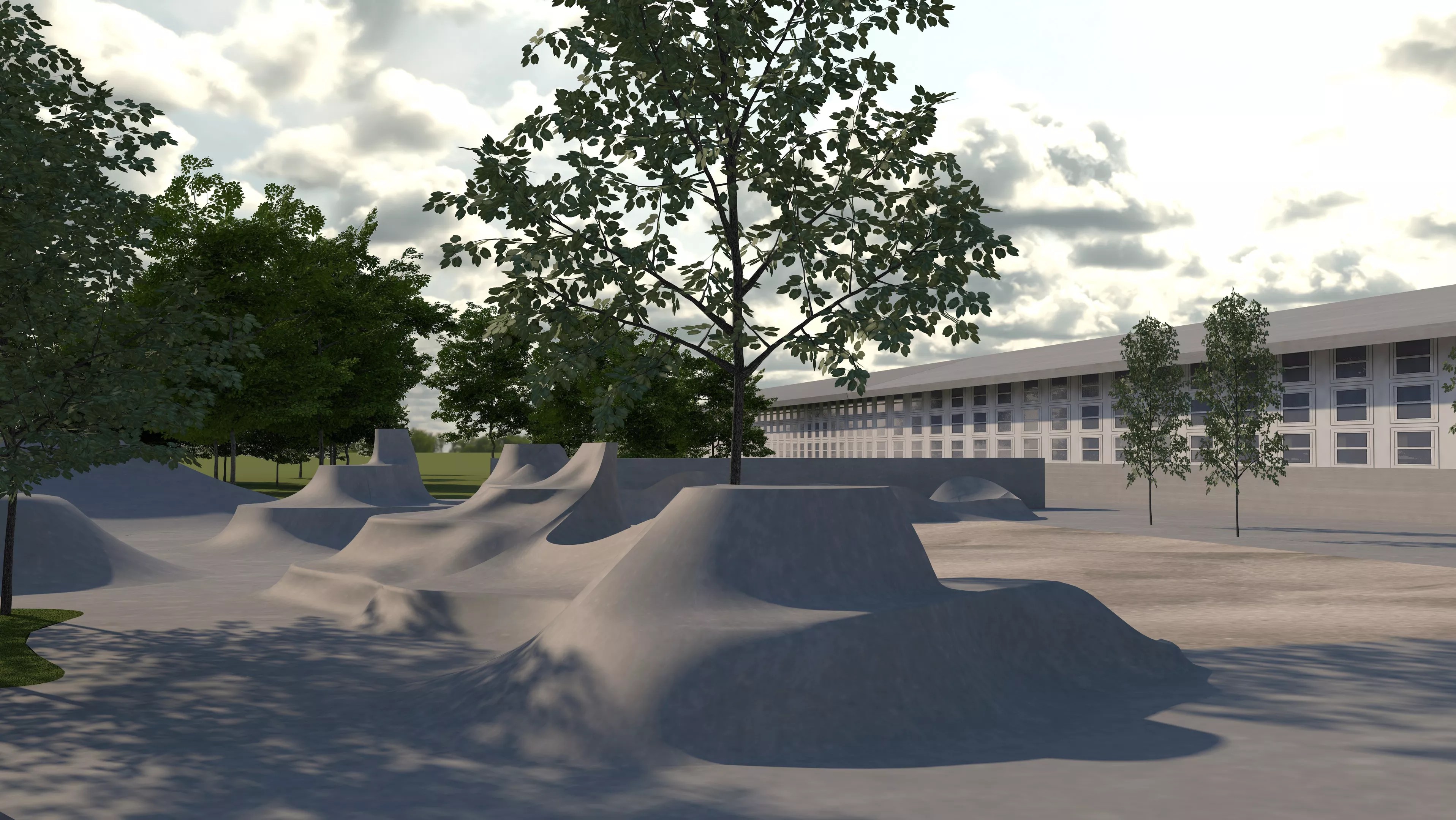
Matt Barton

Audio By Carbonatix
Growing up, artist Matt Barton loved skateboarding. He picked it up starting at age six.
“What is the essence of skateboarding that I was attracted to from the time I was a little kid and I first saw it?” Barton asks. “Our societal norms become rules of how we move our bodies in public space. You’ve got walking, jogging, and then boom: There are total freak-like clowns on wheels that seem like they’re disrupting all those rules. That’s attractive to some kids, because that’s freedom.”
Black Cube, Denver’s nomadic contemporary art museum founded in 2015, is unveiling its first permanent art installation, “Community Forms,” designed by Barton, one of Black Cube’s 2021 artist fellows. “Community Forms” takes inspiration from Barton’s lifelong love of skateboarding and includes abstract forms that encourage social gathering and play.
The installation is in Globeville, at the mixed-use TAXI campus. The opening reception takes place Saturday, May 22, from 2 to 5 p.m. Black Cube representatives, select partners and Barton himself will make remarks starting at 3 p.m. At 4 p.m., the community will enjoy an open skate.
This year, make your gift count –
Invest in local news that matters.
Our work is funded by readers like you who make voluntary gifts because they value our work and want to see it continue. Make a contribution today to help us reach our $50,000 goal!
“Community Forms” is the first project to be awarded a grant from the Federal Emergency Management Agency (FEMA) as part of a public-private partnership between the federal agency and RedLine Contemporary Art Center, which hopes to mitigate disaster-related risks through art. In addition to providing space for people to hang out, “Community Forms” is located right next to the South Platte River and directs water flow from the TAXI campus into bioswales – grassy outlets that slow water flow and prevent flooding.
As Barton explains, water from the site used to drain into one large downspout, which didn’t have a clear route to the South Platte. “We were able to design it in such a way that now we can take that water from the downspout dump right into this little snaking, meandering ditch, and then feed it through the larger part of the site with these bigger forms that guide it and take it further over into the ditch.”
“The sculpture shows a way to channel water,” says Black Cube’s executive director, Cortney Stell. “It’s a novel solution to integrating infrastructure and community.
“Why think about just having ditches everywhere to mitigate floods?” Stell asks. “Or why just think about having a playground somewhere? Why not think about our environment more for multi-use and creative exploration? Infrastructure elements can be used for playscapes.”
The spirit of building forms that could be used creatively for a variety of purposes was important to Barton as he set out on this project. “I wanted to make a public art installation that created a social space and gatherings, that invited creative interpretation.” He adds that he was particularly compelled by “non-prescriptive, behavioral forms designed on a human scale, for a human body to interact with.”
“The forms are designed to invite seating, reclining, lounging,” he explains. “They’re kind of these organic landscape forms that look like how the water cuts through a canyon.”
Stell says that Barton’s piece references land art, a conceptual art movement that was started in the 1960s when artists took interest in molding land for their pieces.
As Barton surveyed the site and began work, he noticed that children at an outdoor academy across the way were huddled up against the fence, watching them transform the area. They asked when it would be done.
“That’s one of the things I’m most excited about seeing: these kids turned loose on the forms and just exploring it,” Barton says. “That’s really the spirit of the whole concept.”
The TAXI campus is a public campus, so “Community Forms” will be open to all. Barton prizes making art that is publicly accessible and that demands interactivity and participation.
Much of his work in the past has also been grounded in social practice, “giving form to human social interactions and creating space for that to happen,” Barton says. “If it’s a unique environment, maybe it will trigger unique interactions. We have so many prescribed spaces; even public spaces with benches. It’s like: The benches are facing a certain way. You’re supposed to sit there and look that way. Even in our public space, we have so many views on how we’re supposed to behave.” Barton hopes his work disrupts these staid norms.
In this respect, Barton’s project is a perfect fit for Black Cube, which hopes to offer contemporary art to audiences in new and unexpected ways.
“Contemporary art has really become a white-cube experience…and that’s become the normative way you experience contemporary art. It’s like, pluck a white cube anywhere, and it’s become the only way people see art,” Stell says. “We think those white-cube experiences have become ostracizing to people who are not comfortable with museums. By literally bringing art to communities, we can produce the most rigorous, experimental museum-quality work – but communities and people can connect with it.”
Comparing “Community Forms” to his previous work, Barton expresses hope that it will stimulate even more natural engagement.
“There’s something about this that feels like the activation and interaction will be more organic and real,” Barton says. “It’ll have its own vitality.”
The opening reception for “Community Forms” will take place on Saturday, May 22, from 2 to 5 p.m., at the TAXI Campus, 3455 Ringsby Court. Participants can RSVP at this link.